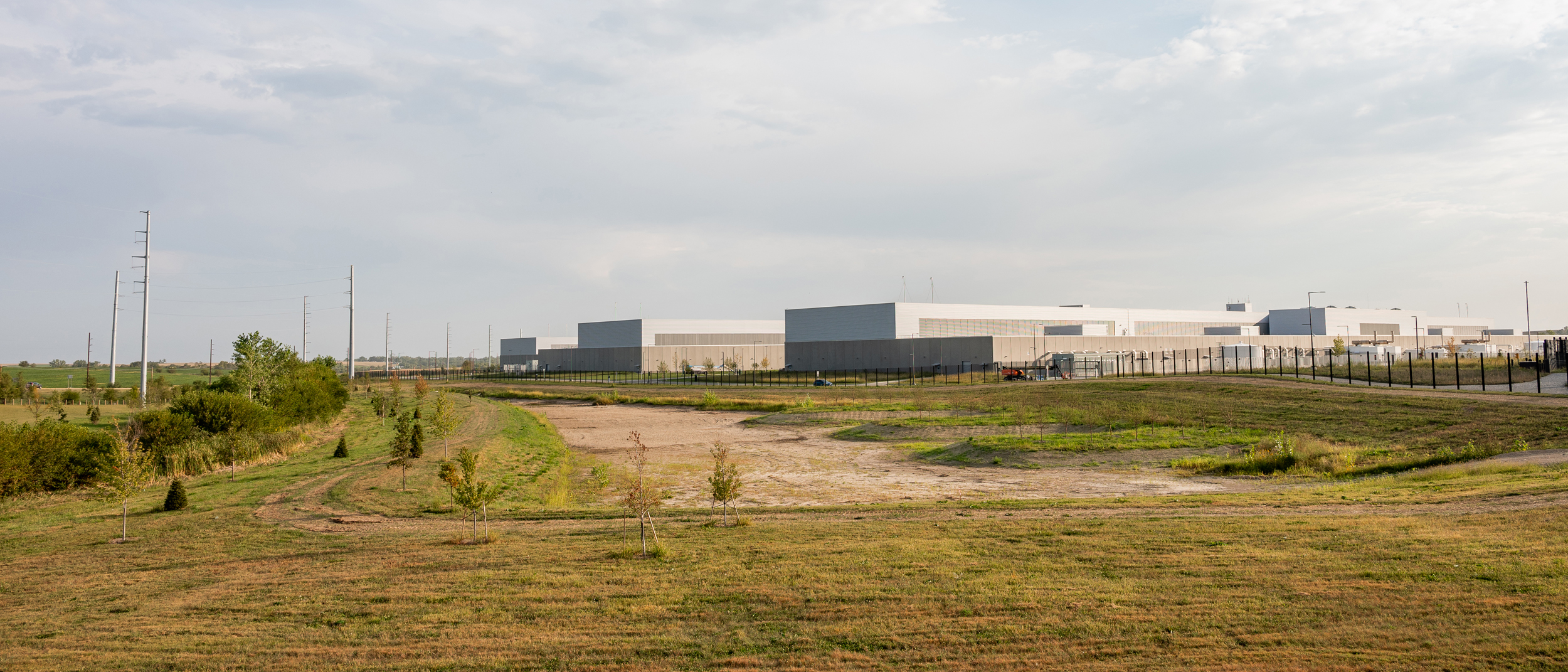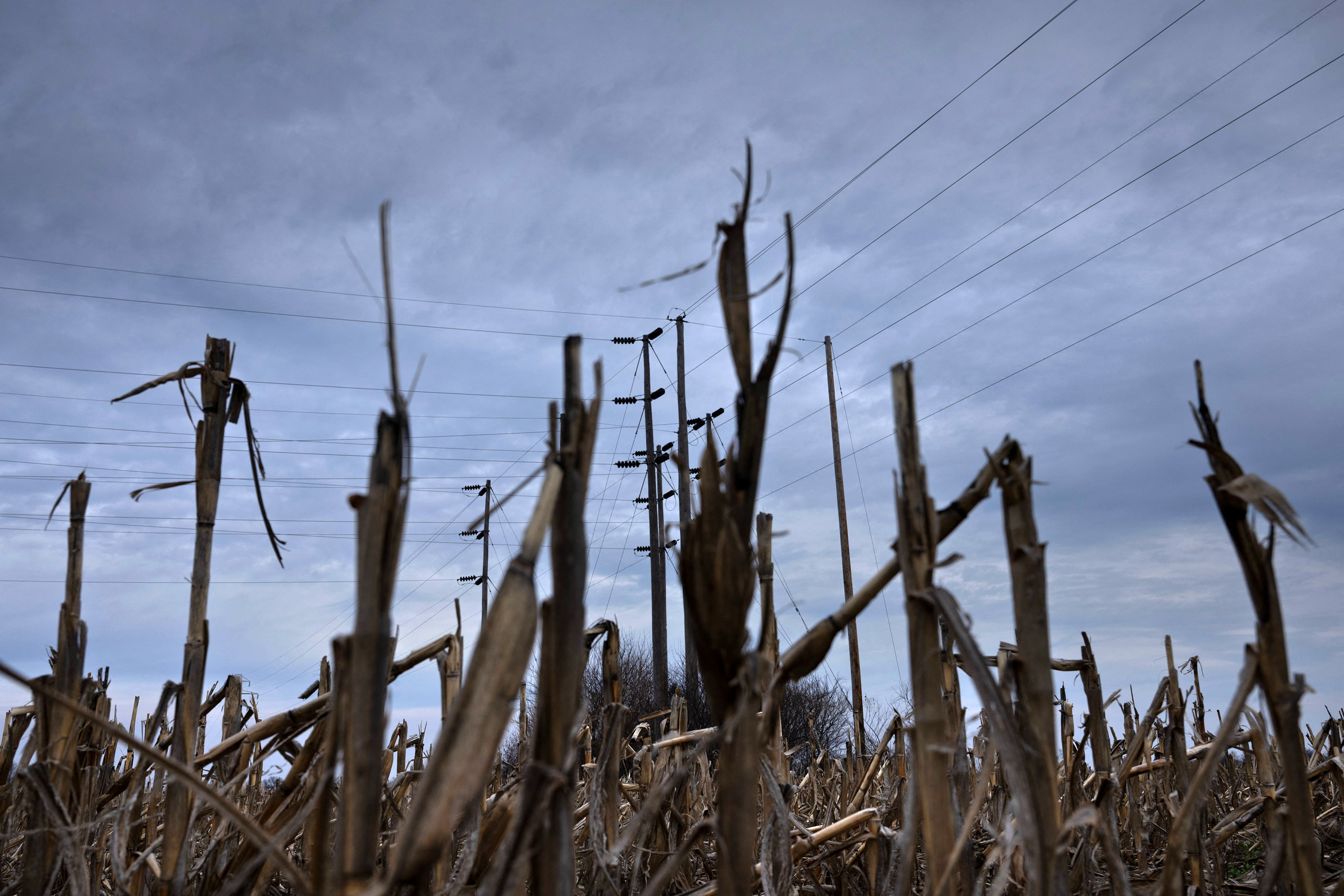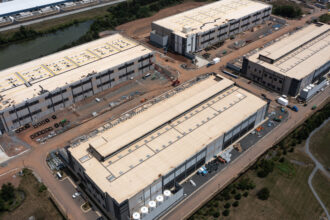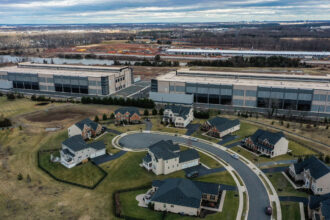TAZEWELL COUNTY, Ill.—To the untrained eye, Central Illinois is all lush fields of corn and green soybeans shortly before harvest. The wind shuffles through the row crops, and the air is warm and humid and full of insects. The horizon is dotted with power lines, strung together by wire, and the occasional water tower—the only objects that disrupt a vast sky.
Coming soon to that horizon, developers hope: a hyperscale data center.
Illinois is a growing hotspot for data centers—massive water- and energy-guzzling server farms, built to service the booming artificial intelligence industry. While many are located in and around Chicago, tech companies seeking cheap energy and water are increasingly building in rural areas as well.
Some of the implications of fast growth will ripple across the state, no matter where the sites pop up. Already, the state is among those seeing skyrocketing electricity bills to pay for transmission upgrade projects supporting data centers.
And if all the current data centers waiting in the queue come online, it would require doubling the state’s electricity grid, said Anna Markowski, who works on Midwestern climate and energy issues at the Natural Resources Defense Council. “That creates a big problem,” she said.
But in rural areas, data center growth poses additional challenges. Much of the Midwest, including three-quarters of Illinois, is farmland. How will this shift, which is shaping up to be one of the largest infrastructure buildouts in U.S. history—and which risks accelerating global warming—affect rural areas increasingly battered by drought-and-downpour climate extremes?
The short answer is, no one really knows. But people are starting to grapple with it as tech companies spend billions in a race to amass land and build as quickly as possible.
For some Illinoisans, it’s a simple matter of jobs and property taxes. Pekin, south of Peoria with a population of about 32,000, recently approved the sale of farmland to a developer to build a 320-plus-acre data center. “We are seeing the future of our city,” Mayor Mary Burress said at a City Council meeting in April.
But people have been arguing on a Facebook page for Pekin residents about the project’s benefits and drawbacks—mirroring conversations playing out across the region.
A recent report from the Wisconsin Farm Bureau Federation raised concerns about the loss of farmland to data centers and its impact on future generations.
In September, residents of Caledonia, a rural village in Wisconsin, questioned whether the jobs and property taxes from a planned Microsoft data center would be worth the cost to their quiet community. It would be the third such site built there.
Minooka, a village in northern Illinois with a population of around 13,000, is also debating the merits of an Equinix proposal to build a 340-acre data center on local farmland.
These are the early days of the building boom, experts believe. By 2030, according to multiple reports, the billions of dollars tech companies are investing in data centers will create considerable changes on the ground.
Expansion in Rural Areas
Dan Swinhoe is the managing editor of Data Center Dynamics, and he’s been covering this industry closely for years. A glance at the publication’s front page indicates massive growth happening all over the U.S.: Wisconsin, Alabama, Texas—not to mention Sweden, South Korea, Spain, Germany and Italy.
Chicago is one of the biggest data center markets, Swinhoe pointed out, but new developments are popping up all across the Midwest. “We’re just in a crazy phase at the moment.”
The key location consideration for developers is access to electricity, he added. “It’s about getting as much power as you can,” Swinhoe said. “You’re seeing a lot of companies just go, like, ‘There is a power line, there is a substation. It’s essentially unused. I’m going to build there.’ And that’s a lot of this kind of rural development you’re seeing.”
This story is funded by readers like you.
Our nonprofit newsroom provides award-winning climate coverage free of charge and advertising. We rely on donations from readers like you to keep going. Please donate now to support our work.
Donate NowIt doesn’t necessarily resemble the data center development in urban areas, either.
“Data centers are more likely to be large-scale in a rural community,” Swinhoe said. “If you’re building on a thousand acres of undeveloped land, you are going to optimize to build the biggest buildings you can.”
Dan Diorio, vice president of state policy at the Data Center Coalition, an industry trade group, said in a statement provided to Inside Climate News that “the data center industry is critical to the future of Illinois’s economy and the state’s clean energy transition.” He cited statistics from a report, prepared by consulting firm PricewaterhouseCoopers for his group, that data centers supported more than 115,000 jobs in Illinois—largely through construction—and contributed about $1.85 billion in state and local tax revenue in 2023. Last year, he said, “half of all clean energy procurement across the country was by companies that operate data centers.”
Kyle Hart, the mid-Atlantic senior program manager for the National Parks Conservation Association, is based in Virginia, known as the data center capital of the world. Because they’ve witnessed nearly two decades of data center growth, people there have more experience with the challenges massive server farms can bring.
“The scale of growth that we’re seeing from a rezoning perspective is truly unmatched,” Hart said. “Developers are turning to undeveloped land all over the state of Virginia to build their facilities. What we are seeing is, for the most part, new data center facilities are being built on open land, and as you know, the expression that exists out there is, ‘Farmland lost is farmland lost forever.’ … That’s the case for any type of development, but data centers are doing it at an alarming rate.”
When data centers are much larger, this can create other side effects as well, Swinhoe said.
“There’ll be more noise, there will be 10 times the amount of generators,” he said. In areas with coal- or gas-heavy electric grids, the power use of large data centers will increase pollution. “Those baseline issues will compound.”

Then there’s the question of water usage—the server farms require immense amounts to cool their servers and keep them functioning. AI and other large users could deplete drinking water supplies across the Midwest, the nonprofit Alliance for the Great Lakes warned in a recent report. In Georgia this summer, taps around a new data center simply stopped working. And as climate change worsens drought, Arizona cities have passed ordinances to protect their water from server farms.
Diorio said in his statement that the industry is working to reduce water use, in some cases through cooling systems that use no water, and “is also committed to paying its full cost of service for the energy it uses, including transmission costs.”
In Virginia, which has been dealing with large-scale data centers in rural areas for decades, Hart has seen other, less discussed consequences.
That development has driven up the price of land, he notes, making it extremely difficult, if not impossible, for new farmers to acquire any. It’s also challenged conservation groups trying to acquire and protect rural land. What’s lost when that land gets developed ranges from flood protections to wildlife habitat to carbon sinks holding back even more global warming.
“Open space provides an inherent community benefit,” Hart said. Any development can reduce those benefits, but with data centers, “the real concern is the scale. … The scale is just absurd.”
Hart thinks politicians in other states can learn from Virginia’s experience. It’s had regional ripple effects because of the multi-state electric grid that reaches as far as northern Illinois.
“People in New Jersey and New York are paying high energy bills this year because of Virginia’s data centers,” he said. “I would hope that other lawmakers, other elected officials, would examine what has happened and try and do better.”
However, the rapid development spurred on by the AI boom is forcing lawmakers to figure out on the fly how to study the impacts and address them appropriately.
Markowski, with the Natural Resources Defense Council, wants Illinois officials to focus on electricity—its cost and how it’s generated, both of which affect people statewide. She’s among those advocating for the state to pass the Clean and Reliable Grid Affordability Act, under consideration in the state’s brief fall veto session this month.
“It’s a very large bill that is adding all sorts of battery backup, storage grid infrastructure upgrades throughout the Illinois grid,” she said.
She added: “We have to understand how resource-rich we are and that that’s what these tech companies want. They want access to our water. They want access to our land and our cheap energy, and they want all the infrastructure. … We shouldn’t be giving it up for nothing, and we shouldn’t be giving it up in a way that hurts our communities.”
About This Story
Perhaps you noticed: This story, like all the news we publish, is free to read. That’s because Inside Climate News is a 501c3 nonprofit organization. We do not charge a subscription fee, lock our news behind a paywall, or clutter our website with ads. We make our news on climate and the environment freely available to you and anyone who wants it.
That’s not all. We also share our news for free with scores of other media organizations around the country. Many of them can’t afford to do environmental journalism of their own. We’ve built bureaus from coast to coast to report local stories, collaborate with local newsrooms and co-publish articles so that this vital work is shared as widely as possible.
Two of us launched ICN in 2007. Six years later we earned a Pulitzer Prize for National Reporting, and now we run the oldest and largest dedicated climate newsroom in the nation. We tell the story in all its complexity. We hold polluters accountable. We expose environmental injustice. We debunk misinformation. We scrutinize solutions and inspire action.
Donations from readers like you fund every aspect of what we do. If you don’t already, will you support our ongoing work, our reporting on the biggest crisis facing our planet, and help us reach even more readers in more places?
Please take a moment to make a tax-deductible donation. Every one of them makes a difference.
Thank you,











